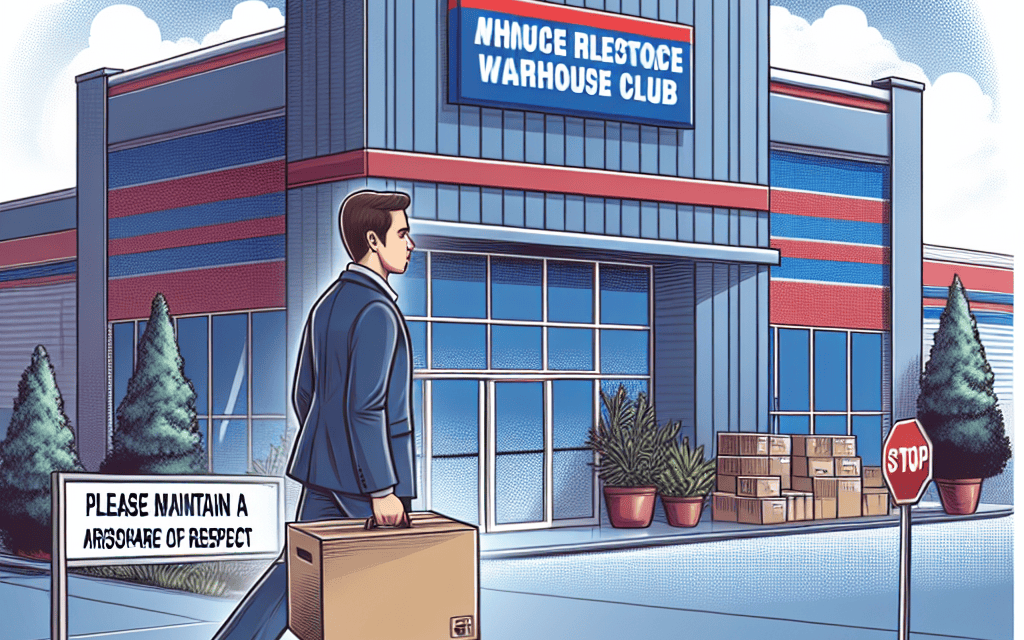“Leadership Shifts: Navigating Change as Sam’s Club Faces Walmart’s Strategic Moves”
Introduction
In a significant corporate shake-up, Sam’s Club, a division of retail giant Walmart Inc., is experiencing notable executive departures following Walmart’s recent strategic decision to relocate its headquarters. This move, aimed at consolidating operations and fostering a more integrated corporate environment, has prompted several high-ranking executives at Sam’s Club to reconsider their positions within the company. The exits underscore the challenges and disruptions that can accompany major organizational changes, particularly in a competitive retail landscape where leadership stability is crucial. As Walmart pushes forward with its relocation directive, the departures at Sam’s Club highlight the broader implications for leadership dynamics and strategic continuity within the organization.
Impact Of Leadership Changes At Sam’s Club On Business Strategy
The recent departure of a key executive from Sam’s Club, a subsidiary of Walmart, has sparked discussions about the potential impact on the company’s business strategy. This exit comes in the wake of Walmart’s new directive to relocate its corporate staff, a move that has already stirred significant changes within the organization. As Sam’s Club navigates this transition, understanding the implications of leadership changes becomes crucial for stakeholders and industry observers alike.
Leadership transitions often bring about shifts in strategic direction, and Sam’s Club is no exception. The executive’s exit could lead to a reevaluation of current strategies, particularly those aligned with Walmart’s broader objectives. Historically, Sam’s Club has operated with a degree of autonomy, allowing it to tailor its approach to the unique demands of the wholesale club market. However, with Walmart’s increasing emphasis on centralization and efficiency, there may be pressure to align more closely with the parent company’s overarching goals.
Moreover, the relocation directive itself is indicative of Walmart’s strategic priorities. By consolidating its workforce in specific locations, Walmart aims to foster greater collaboration and streamline operations. This move could potentially influence Sam’s Club’s strategic initiatives, as the company may need to adapt to new operational frameworks and cultural shifts. The departure of a key executive during this period of change could either hinder or accelerate these adaptations, depending on how the transition is managed.
In addition to internal dynamics, external market conditions also play a significant role in shaping Sam’s Club’s strategy. The wholesale club industry is highly competitive, with major players like Costco and BJ’s Wholesale Club vying for market share. In this context, leadership stability is crucial for maintaining a competitive edge. The executive’s exit could create a temporary leadership vacuum, potentially affecting decision-making processes and strategic planning. However, it also presents an opportunity for fresh perspectives and innovative approaches to emerge, which could ultimately benefit the company in the long run.
Furthermore, the impact of leadership changes extends beyond immediate strategic concerns. Employee morale and organizational culture are also at stake. Leadership transitions can create uncertainty among staff, affecting productivity and engagement. It is essential for Sam’s Club to communicate effectively with its employees during this period, ensuring that they remain informed and motivated. By fostering a transparent and supportive environment, the company can mitigate potential disruptions and maintain a cohesive workforce.
In conclusion, the exit of a key executive from Sam’s Club amid Walmart’s relocation directive presents both challenges and opportunities for the company. While the transition may necessitate adjustments in business strategy, it also offers a chance to realign with evolving market demands and organizational priorities. As Sam’s Club navigates this period of change, the focus should be on leveraging leadership transitions to drive innovation and enhance competitiveness. By doing so, the company can position itself for sustained growth and success in the dynamic wholesale club industry.
Walmart’s Relocation Directive: Implications For Sam’s Club Executives
In a significant development within the retail industry, a high-ranking executive at Sam’s Club has decided to part ways with the company, following Walmart’s recent directive to relocate its corporate staff. This decision has sparked discussions about the broader implications of Walmart’s relocation strategy, particularly for its subsidiary, Sam’s Club, and its leadership team. As Walmart, the parent company of Sam’s Club, continues to implement strategic changes to optimize its operations, the relocation directive has emerged as a pivotal move aimed at consolidating its workforce and enhancing collaboration across its various divisions.
The relocation directive, which mandates that certain corporate roles be moved to specific hubs, is part of Walmart’s broader strategy to streamline operations and foster a more cohesive corporate culture. However, this initiative has not been without its challenges, particularly for executives who are deeply rooted in their current locations. The departure of a Sam’s Club executive underscores the personal and professional dilemmas faced by leaders who are confronted with the prospect of relocation. For some, the decision to relocate may involve significant lifestyle changes, impacting family dynamics and personal commitments. Consequently, the directive has prompted a reevaluation of career trajectories among Sam’s Club executives, as they weigh the benefits of remaining with the company against the potential disruptions caused by relocation.
Moreover, the exit of a key executive raises questions about the potential impact on Sam’s Club’s strategic direction and operational continuity. Leadership transitions can often lead to shifts in corporate priorities and strategies, as new leaders bring their own perspectives and approaches to the table. In the case of Sam’s Club, maintaining stability and continuity in its leadership team is crucial, especially as the company navigates an increasingly competitive retail landscape. The departure of an executive could necessitate a realignment of responsibilities within the leadership team, potentially affecting decision-making processes and the execution of strategic initiatives.
In addition to internal implications, the relocation directive and subsequent executive exit may also influence external perceptions of Sam’s Club and Walmart. Stakeholders, including investors, employees, and customers, are likely to scrutinize these developments closely, assessing their potential impact on the company’s performance and long-term prospects. For investors, leadership stability is often a key consideration, as it can affect a company’s ability to execute its strategic vision effectively. Similarly, employees may view the relocation directive as a signal of broader organizational changes, prompting concerns about job security and career advancement opportunities.
Furthermore, the relocation directive highlights the evolving nature of corporate work environments in the post-pandemic era. As companies reassess their operational models, the balance between remote work and in-person collaboration has become a focal point of discussion. Walmart’s decision to consolidate its workforce in specific locations reflects a broader trend among corporations seeking to enhance collaboration and innovation through physical proximity. However, this approach must be carefully balanced with the need to accommodate the diverse needs and preferences of employees, particularly those in leadership positions.
In conclusion, the exit of a Sam’s Club executive amid Walmart’s relocation directive underscores the complex interplay between corporate strategy and individual decision-making. As Walmart continues to refine its operational model, the implications for Sam’s Club and its leadership team will be closely monitored by industry observers. The ability to navigate these changes effectively will be critical to ensuring the continued success and competitiveness of both Sam’s Club and Walmart in the dynamic retail landscape.
Analyzing The Reasons Behind Executive Exits At Sam’s Club
In recent developments within the corporate landscape, the departure of a key executive from Sam’s Club has sparked discussions about the underlying reasons for such exits. This event comes in the wake of Walmart’s strategic decision to relocate its corporate headquarters, a move that has had significant implications for its subsidiaries, including Sam’s Club. Understanding the factors contributing to executive exits in this context requires a closer examination of the broader corporate strategies and the personal considerations of those involved.
Walmart’s decision to relocate its headquarters is part of a larger effort to streamline operations and foster a more cohesive corporate culture. By consolidating its various offices into a single, state-of-the-art campus, Walmart aims to enhance collaboration and innovation across its divisions. However, such a significant transition inevitably brings challenges, particularly for executives who may face personal and professional upheaval as a result. The relocation directive has prompted some executives to reassess their positions, weighing the benefits of staying with the company against the personal costs of moving.
For Sam’s Club, a subsidiary of Walmart, the impact of this relocation is particularly pronounced. As a membership-only retail warehouse club, Sam’s Club operates under a distinct business model that requires a unique strategic approach. The departure of an executive from Sam’s Club can be attributed, in part, to the complexities of aligning its operations with Walmart’s overarching goals while maintaining its own identity and market position. Executives at Sam’s Club must navigate the delicate balance between adhering to corporate directives and preserving the brand’s autonomy, a task that becomes even more challenging amid significant organizational changes.
Moreover, the decision to relocate can also affect the personal lives of executives, influencing their willingness to remain with the company. Relocation often involves uprooting families, adjusting to new environments, and managing the logistical challenges of moving. For some executives, these personal considerations may outweigh the professional benefits of staying with the company, leading them to seek opportunities elsewhere. This is particularly true for those who have established deep roots in their current locations or who have family obligations that make relocation impractical.
In addition to personal and logistical factors, the evolving retail landscape plays a crucial role in executive turnover. The retail industry is undergoing rapid transformation, driven by technological advancements and shifting consumer preferences. Executives at Sam’s Club and other retail giants must constantly adapt to these changes, developing innovative strategies to remain competitive. The pressure to deliver results in such a dynamic environment can contribute to executive burnout, prompting some to leave in search of new challenges or a more balanced lifestyle.
Furthermore, the competitive nature of the retail sector means that talented executives are often in high demand. As companies vie for top talent, executives may be presented with lucrative offers from other organizations, providing them with compelling reasons to consider leaving. This competitive landscape underscores the importance of retaining key personnel, as their departure can disrupt operations and hinder strategic initiatives.
In conclusion, the exit of a Sam’s Club executive amid Walmart’s relocation directive highlights the multifaceted reasons behind such departures. While corporate strategies and personal considerations play significant roles, the broader context of an evolving retail industry and competitive job market cannot be overlooked. As companies like Sam’s Club navigate these challenges, understanding the motivations behind executive exits becomes crucial for maintaining stability and achieving long-term success.
How Sam’s Club Is Navigating Leadership Transitions

In recent developments within the retail industry, Sam’s Club, a subsidiary of Walmart Inc., is experiencing a significant shift in its leadership structure. This change comes in the wake of Walmart’s strategic decision to relocate its corporate headquarters from Bentonville, Arkansas, to a new campus. The relocation directive has prompted a wave of executive exits, with one of the most notable being a high-ranking executive at Sam’s Club. This transition period presents both challenges and opportunities for the wholesale club as it navigates the complexities of leadership changes while maintaining its operational efficiency and strategic goals.
The departure of a key executive can often lead to a period of uncertainty within any organization. However, Sam’s Club is taking proactive steps to ensure a smooth transition. By leveraging its robust internal talent pool and focusing on succession planning, the company aims to fill the leadership void with individuals who possess a deep understanding of its business model and culture. This approach not only minimizes disruption but also reinforces the company’s commitment to continuity and stability.
Moreover, Sam’s Club is utilizing this transition as an opportunity to reassess its strategic priorities. With the retail landscape constantly evolving, the company recognizes the importance of adapting to changing consumer preferences and technological advancements. The leadership change provides a fresh perspective, allowing Sam’s Club to realign its strategies to better meet the needs of its members. This includes enhancing its digital capabilities, optimizing supply chain operations, and expanding its product offerings to remain competitive in the wholesale market.
In addition to internal adjustments, Sam’s Club is also focusing on strengthening its relationship with Walmart. As a subsidiary, Sam’s Club benefits from the resources and expertise of its parent company. The relocation of Walmart’s headquarters is expected to foster closer collaboration between the two entities, enabling Sam’s Club to leverage Walmart’s extensive network and infrastructure. This synergy is anticipated to drive innovation and efficiency, ultimately enhancing the value proposition for Sam’s Club members.
Furthermore, the leadership transition at Sam’s Club is being closely monitored by industry analysts and stakeholders. The company’s ability to navigate this period successfully will be indicative of its resilience and adaptability in a competitive market. By maintaining transparency and open communication with its employees, members, and partners, Sam’s Club aims to build trust and confidence during this transitional phase.
As Sam’s Club moves forward, it remains committed to its core mission of providing exceptional value and service to its members. The leadership change, while significant, is viewed as an opportunity to reinforce this mission and drive future growth. By embracing change and focusing on strategic priorities, Sam’s Club is well-positioned to continue its trajectory of success in the retail industry.
In conclusion, the exit of a key executive amid Walmart’s relocation directive marks a pivotal moment for Sam’s Club. However, through strategic planning, collaboration, and a commitment to its members, the company is poised to navigate this leadership transition effectively. As it adapts to new challenges and opportunities, Sam’s Club remains dedicated to delivering value and innovation, ensuring its continued relevance and success in the ever-evolving retail landscape.
The Future Of Sam’s Club Under New Executive Leadership
The recent departure of a key executive from Sam’s Club has sparked discussions about the future trajectory of the retail giant under new leadership. This change comes in the wake of Walmart’s strategic decision to relocate its corporate headquarters, a move that has prompted significant shifts within its subsidiary, Sam’s Club. As the company navigates this transition, stakeholders are keenly observing how the new executive leadership will steer Sam’s Club in an increasingly competitive retail landscape.
The executive’s exit, while unexpected, is not entirely surprising given the broader context of Walmart’s relocation directive. This strategic move is part of Walmart’s efforts to consolidate its operations and foster a more cohesive corporate culture. However, it has also led to a reshuffling of talent, as some executives have opted not to relocate. Consequently, Sam’s Club is now poised to embrace fresh leadership perspectives that could redefine its strategic priorities.
Under the new executive leadership, Sam’s Club is expected to focus on several key areas to maintain its competitive edge. One of the primary objectives will likely be enhancing the customer experience, a critical factor in retaining and expanding its membership base. By leveraging advanced data analytics and customer insights, the new leadership can tailor offerings to meet the evolving needs of consumers. This approach not only aligns with current retail trends but also positions Sam’s Club to better compete with other membership-based retailers.
Moreover, the new leadership is anticipated to place a strong emphasis on digital transformation. In recent years, the retail industry has witnessed a significant shift towards e-commerce, a trend accelerated by the global pandemic. As such, Sam’s Club must continue to innovate its digital platforms to provide seamless online shopping experiences. This includes optimizing its website and mobile app, enhancing delivery and pickup options, and integrating cutting-edge technologies such as artificial intelligence and machine learning to personalize the shopping journey.
In addition to digital advancements, sustainability is likely to be a focal point for Sam’s Club under its new leadership. As consumers become increasingly conscious of environmental issues, retailers are under pressure to adopt sustainable practices. Sam’s Club can capitalize on this trend by implementing eco-friendly initiatives across its supply chain, reducing waste, and promoting sustainable products. Such efforts not only appeal to environmentally conscious consumers but also contribute to the company’s long-term viability.
Furthermore, the new executive team will need to address the challenges posed by supply chain disruptions, which have become a persistent issue in the retail sector. By investing in robust supply chain management systems and fostering strong relationships with suppliers, Sam’s Club can mitigate these challenges and ensure a steady flow of products to its members.
As Sam’s Club embarks on this new chapter, the role of leadership will be crucial in navigating the complexities of the modern retail environment. The ability to adapt to changing consumer preferences, embrace technological advancements, and implement sustainable practices will be key determinants of success. While the departure of a seasoned executive presents challenges, it also offers an opportunity for Sam’s Club to infuse fresh ideas and strategies into its operations.
In conclusion, the future of Sam’s Club under new executive leadership holds promise, provided that the company remains agile and responsive to the dynamic retail landscape. By prioritizing customer experience, digital innovation, sustainability, and supply chain resilience, Sam’s Club can continue to thrive and maintain its position as a leader in the membership-based retail sector. As the company moves forward, all eyes will be on how effectively the new leadership can translate these strategic priorities into tangible results.
Walmart’s Strategic Moves And Their Effect On Sam’s Club Operations
In recent developments within the retail industry, the departure of a key executive from Sam’s Club has sparked discussions about the broader implications of Walmart’s strategic decisions. This executive exit comes in the wake of Walmart’s recent directive to relocate certain operations, a move that has been met with both anticipation and apprehension within the company. As Walmart continues to refine its business strategies, the ripple effects on its subsidiary, Sam’s Club, are becoming increasingly evident.
Walmart, the parent company of Sam’s Club, has long been a dominant force in the retail sector, known for its ability to adapt to changing market conditions. The decision to relocate certain operations is part of Walmart’s broader strategy to streamline its business processes and enhance efficiency. This relocation directive is aimed at consolidating resources and optimizing supply chain logistics, which are critical components in maintaining Walmart’s competitive edge. However, such strategic moves often come with significant organizational changes, and the recent executive exit at Sam’s Club underscores the challenges that can arise during periods of transition.
The executive in question played a pivotal role in shaping Sam’s Club’s operational strategies, and their departure raises questions about the future direction of the company. While Walmart’s relocation efforts are intended to bolster overall performance, the impact on Sam’s Club’s internal dynamics cannot be overlooked. The departure of a key leader can lead to a period of uncertainty, as the company must navigate the complexities of leadership transition while maintaining its operational momentum.
Moreover, the relocation directive has broader implications for Sam’s Club’s workforce and operational structure. Employees may face changes in their roles or locations, which can affect morale and productivity. It is crucial for Sam’s Club to manage these changes effectively to ensure a smooth transition and maintain employee engagement. Communication will play a vital role in this process, as transparent and timely updates can help alleviate concerns and foster a sense of stability among the workforce.
In addition to internal challenges, Sam’s Club must also consider the external market environment. The retail landscape is highly competitive, with evolving consumer preferences and technological advancements driving constant change. As Walmart implements its relocation strategy, Sam’s Club must remain agile and responsive to market demands. This may involve reassessing its product offerings, enhancing customer experiences, and leveraging data analytics to gain insights into consumer behavior.
Furthermore, the executive exit and relocation directive highlight the interconnectedness of Walmart and Sam’s Club’s operations. While Sam’s Club operates as a separate entity, its success is closely tied to Walmart’s overarching strategies. As such, any changes at the parent company level can have cascading effects on Sam’s Club’s performance. It is essential for both entities to align their goals and collaborate effectively to achieve mutual success.
In conclusion, the recent executive exit at Sam’s Club amid Walmart’s relocation directive underscores the complexities of strategic decision-making in the retail industry. While Walmart’s efforts to optimize operations are aimed at enhancing overall performance, the impact on Sam’s Club’s internal dynamics and market positioning cannot be ignored. As the company navigates this period of transition, effective leadership, clear communication, and strategic agility will be key to ensuring continued success in a rapidly evolving retail landscape.
Executive Turnover At Sam’s Club: Challenges And Opportunities
In a significant development within the retail industry, Sam’s Club, a division of Walmart Inc., is experiencing a notable shift in its executive ranks. This change comes in the wake of Walmart’s recent directive to relocate certain corporate roles to its headquarters in Bentonville, Arkansas. The decision has prompted a wave of executive turnover, with some leaders opting to exit the company rather than make the move. This transition presents both challenges and opportunities for Sam’s Club as it navigates the evolving landscape of retail management.
The departure of key executives is not an uncommon phenomenon in large corporations, especially when strategic shifts necessitate relocation. However, the timing of these exits is critical for Sam’s Club, which is striving to maintain its competitive edge in the wholesale club sector. The decision to centralize operations in Bentonville is part of Walmart’s broader strategy to streamline processes and foster closer collaboration among its various divisions. While this move is intended to enhance operational efficiency, it inevitably disrupts the existing organizational structure, leading to a reshuffling of leadership roles.
For Sam’s Club, the challenge lies in ensuring a seamless transition that minimizes disruption to its business operations. The departure of experienced executives can create a temporary leadership vacuum, potentially affecting decision-making and strategic planning. However, this situation also presents an opportunity for the company to infuse fresh perspectives into its leadership team. By bringing in new talent or promoting from within, Sam’s Club can rejuvenate its executive ranks and drive innovation in its business model.
Moreover, the relocation directive underscores the importance of adaptability in today’s corporate environment. As companies increasingly prioritize agility and responsiveness, executives must be willing to embrace change and relocate if necessary. This flexibility is crucial for aligning with corporate strategies and maintaining a cohesive organizational culture. For those who choose to stay with the company, the move to Bentonville offers a chance to be at the heart of Walmart’s operations, where they can contribute more directly to the company’s overarching goals.
In addition to internal challenges, Sam’s Club must also contend with external pressures from competitors in the wholesale club market. Rivals such as Costco and BJ’s Wholesale Club continue to expand their footprints and enhance their offerings, intensifying the competition for market share. In this context, effective leadership is paramount for Sam’s Club to differentiate itself and capitalize on growth opportunities. The company must leverage its strengths, such as its extensive product range and member-centric approach, to attract and retain customers.
Furthermore, the executive turnover at Sam’s Club highlights the broader trend of leadership changes across the retail industry. As consumer preferences evolve and technology reshapes the shopping experience, companies must continually reassess their leadership strategies to stay relevant. This dynamic environment calls for leaders who are not only adept at navigating change but also capable of driving transformation within their organizations.
In conclusion, the exit of executives from Sam’s Club amid Walmart’s relocation directive presents both challenges and opportunities for the company. While the transition may pose short-term disruptions, it also offers a chance to revitalize the leadership team and align more closely with corporate objectives. As Sam’s Club adapts to these changes, its ability to effectively manage this executive turnover will be crucial in maintaining its competitive position in the retail landscape.
Q&A
1. **Question:** What prompted the executive exits at Sam’s Club?
– **Answer:** The executive exits at Sam’s Club were prompted by Walmart’s relocation directive, which required certain executives to move to the company’s headquarters.
2. **Question:** How many executives left Sam’s Club due to the relocation directive?
– **Answer:** The exact number of executives who left Sam’s Club due to the relocation directive is not specified.
3. **Question:** What was the main reason for the executives’ decision to leave Sam’s Club?
– **Answer:** The main reason for the executives’ decision to leave was their unwillingness or inability to relocate to the headquarters as required by the directive.
4. **Question:** Which company issued the relocation directive affecting Sam’s Club executives?
– **Answer:** Walmart, the parent company of Sam’s Club, issued the relocation directive.
5. **Question:** What impact did the executive exits have on Sam’s Club’s operations?
– **Answer:** The impact on Sam’s Club’s operations is not detailed, but such exits typically lead to transitional challenges and potential disruptions in leadership continuity.
6. **Question:** Were there any specific roles or departments at Sam’s Club that were more affected by the executive exits?
– **Answer:** The specific roles or departments affected by the executive exits are not mentioned.
7. **Question:** How has Walmart responded to the executive exits at Sam’s Club?
– **Answer:** Walmart’s response to the executive exits is not detailed, but companies typically work on filling the vacancies and ensuring smooth transitions.
Conclusion
The recent executive exits at Sam’s Club, a subsidiary of Walmart, highlight the challenges and potential internal disagreements arising from Walmart’s relocation directive. This strategic move, aimed at consolidating operations and possibly reducing costs, may have led to dissatisfaction among key personnel, resulting in their departure. Such exits could impact Sam’s Club’s operational stability and strategic direction in the short term. However, it also presents an opportunity for Walmart to realign its leadership with its broader corporate objectives, potentially bringing in new talent that aligns more closely with its vision. The situation underscores the complexities large corporations face when implementing significant organizational changes and the importance of managing internal stakeholder expectations to maintain continuity and morale.





